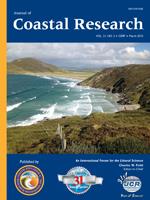Rahaman, S.M.B.; Rahaman, M.S.; Ghosh, A.K.; Gain, D.; Biswas, S.K.; Sarder, L.; Islam, S.S., and Sayeed, A.B., 2015. A spatial and seasonal pattern of water quality in the Sundarbans river systems of Bangladesh.
Comprehensive field measurements were made in three major river systems (RSs) of the Sundarbans during October 2010 to August 2011 under post-monsoon, dry winter, and monsoon seasons to assess the pollution status. Fifteen experimental sites were set for collection of water samples from discrete layers under different tidal conditions. Salinity, temperature, pH, and dissolved oxygen (DO) were determined in situ and chemical oxygen demand (COD), biological oxygen demand (BOD), total nitrogen (TN), total phosphorus (TP), nitrate, phosphate, and ammonium were measured through laboratory analysis. Mean DO was recorded between 3.93 and 7.37 mg/L with an average 5.44 mg/L. Highest average DO was noticed at Rupsha-Passur RS during post-monsoon, whereas the lowest was in Kholpetua-Arpangashia RS during monsoon. Mean BOD ranges between 0.3 and 4.1 mg O2/L, with an average of 2.04 mg O2/L, where maximum and minimum concentrations were measured at Kholpetua-Arpangashia RS in monsoon and dry winter respectively. Mean COD was found to vary from 20 to 240 mg O2/L, with an average 121.33 mg O2/L, exceeding the permissible range of 4–8 mg O2/L. Rupsha-Passur RS shows lowest average COD during post-monsoon, whereas Kholpetua-Arpangashia RS indicated highest COD in winter. Measured COD was higher in the dry season than in the wet season because of precipitation that causes dilution in the RSs. The study indicates the existence of organic pollution, though the DO concentration was within the permissible limit. Analyzed water samples showed nitrate, phosphate, and ammonium values in the range of 0.083 ± 0.03 to 0.627 ± 0.42 mg/L, 0.011 ± 0.005 to 0.449 ± 0.26 mg/L, and 0.038 ± 0.018 to 0.176 ± 0.16 mg/L respectively. TN and TP concentrations were not high enough in most cases, as there is a chance of eutrophication due to algal pollution. Study results will help identify factors responsible for affecting the biodiversity of the Sundarbans intertidal mangrove forest.





